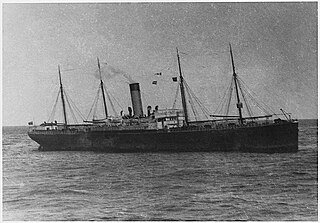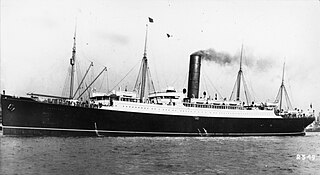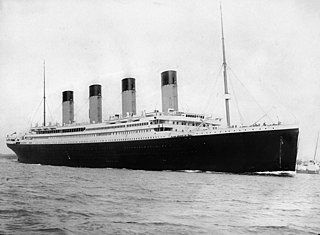
Stanley Phillip Lord was captain of the SS Californian, the nearest ship to the Titanic on the night it sank on 15 April 1912, and, depending on which sources are believed, likely the only ship to see the Titanic, or at least its rockets, during the sinking. Lord, and the Californian more generally, have been criticized for the fact that the Californian did not render timely assistance to the Titanic despite being only 20 miles away and the only ship that could have reached Titanic before she sank. Two official inquiries were critical of Lord, but did not recommend criminal charges. Subsequent authors have offered differing opinions on Lord's actions, with some defending, and others criticizing him. The passion among the two factions has resulted in the labels of "Lordites" and "Anti-Lordites" being applied to the two camps. Central points of debate typically include the appropriateness of Lord's response to the rockets, whether the Californian and Titanic were in fact visible to one another, the possible presence of one or more "Mystery Ships" that may have been the ships seen by either the Titanic or Californian, and whether or not the Californian could have saved any additional lives had it attempted to render assistance more quickly.

RMS Olympic was a British ocean liner and the lead ship of the White Star Line's trio of Olympic-class liners. Unlike the other ships in the class, Olympic had a long career spanning 24 years from 1911 to 1935. This included service as a troopship during the First World War, which gained her the nickname "Old Reliable". She returned to civilian service after the war, and served successfully as an ocean liner throughout the 1920s and into the first half of the 1930s, although increased competition, and the slump in trade during the Great Depression after 1930, made her operation increasingly unprofitable.

HMHSBritannic was the third vessel of the White Star Line's Olympic class of steamships and the second White Star ship to bear the name Britannic. She was the fleet mate of both the RMS Olympic and the RMS Titanic and was intended to enter service as a transatlantic passenger liner.

SS Californian was a British Leyland Line steamship that is best known for its inaction during the sinking of the RMS Titanic on 15 April 1912, despite being the closest ship in the area. The United States Senate inquiry and British Wreck Commissioner's inquiry into the sinking both concluded that the Californian could have saved many or all of the lives that were lost, had a prompt response been mounted to the Titanic's distress rockets. The U.S. Senate inquiry was particularly critical of the vessel's Captain, Stanley Lord, calling his inaction during the disaster "reprehensible".

RMS Empress of Ireland was an ocean liner that sank near the mouth of the Saint Lawrence River following a collision in thick fog with the Norwegian collier SS Storstad in the early hours of 29 May 1914. Although the ship was equipped with watertight compartments and, in the aftermath of the Titanic disaster two years earlier, carried more than enough lifeboats for all onboard, she foundered in only 14 minutes. Of the 1,477 people on board, 1,012 died, making it the worst peacetime marine disaster in Canadian history.

The sinking of the RMS Titanic in 1912 shocked the world, and attracted so much controversy that a number of conspiracy theories have been put forward regarding the disaster.

The International Ice Patrol is an organization with the purpose of monitoring the presence of icebergs in the Atlantic and Arctic Oceans and reporting their movements for safety purposes. It is operated by United States Coast Guard but is funded by the 13 nations interested in trans-Atlantic navigation. As of 2011 the governments contributing to the International Ice Patrol include Belgium, Canada, Denmark, Finland, France, Germany, Greece, Italy, Japan, the Netherlands, Norway, Panama, Poland, Spain, Sweden, the United Kingdom, and the United States.

Commander Harold Godfrey Lowe RD, RNR was the fifth officer of the RMS Titanic.

Eva Miriam Hart MBE was a survivor of the sinking of the RMS Titanic on 15 April 1912.

The RMS Titanic sank in the early morning hours of 15 April 1912 in the North Atlantic Ocean, four days into the ship's maiden voyage from Southampton to New York City. The largest ocean liner in service at the time, Titanic had an estimated 2,224 people on board when she struck an iceberg at around 23:40 on Sunday, 14 April 1912. Her sinking two hours and forty minutes later at 02:20 on Monday, 15 April, resulted in the deaths of more than 1,500 people, making it one of the deadliest peacetime marine disasters in history.

The Olympic-class ocean liners were a trio of British ocean liners built by the Harland & Wolff shipyard for the White Star Line during the early 20th century. They were Olympic (1911), Titanic (1912), and Britannic (1915). All three were designed to be the largest and most luxurious passenger ships in the world, designed to give White Star an advantage in the transatlantic passenger trade.

The RMS Carpathia was a Cunard Line transatlantic passenger steamship built by Swan Hunter & Wigham Richardson in their shipyard in Newcastle upon Tyne, England.

USCGC Seneca, or before 1915 USRC Seneca, was a United States Coast Guard cutter built and commissioned as a "derelict destroyer" with the specific mission of locating and then destroying abandoned shipwrecks that were still afloat and were a menace to navigation. She was designed with excellent sea-keeping qualities, a long cruising range, good towing capabilities, and by necessity the capacity to store a large amount of munitions. She was one of five Coast Guard cutters serving with the U.S. Navy in European waters during World War I.

A lifeboat or life raft is a small, rigid or inflatable boat carried for emergency evacuation in the event of a disaster aboard a ship. Lifeboat drills are required by law on larger commercial ships. Rafts (liferafts) are also used. In the military, a lifeboat may double as a whaleboat, dinghy, or gig. The ship's tenders of cruise ships often double as lifeboats. Recreational sailors usually carry inflatable life rafts, though a few prefer small proactive lifeboats that are harder to sink and can be sailed to safety.

RMS Titanic was a British passenger liner operated by the White Star Line that sank in the North Atlantic Ocean in the early morning hours of 15 April 1912, after striking an iceberg during her maiden voyage from Southampton to New York City. Of the estimated 2,224 passengers and crew aboard, more than 1,500 died, making the sinking one of modern history's deadliest peacetime commercial marine disasters. RMS Titanic was the largest ship afloat at the time she entered service and was the second of three Olympic-class ocean liners operated by the White Star Line. She was built by the Harland and Wolff shipyard in Belfast. Thomas Andrews, chief naval architect of the shipyard at the time, died in the disaster.

There have been several legends and myths surrounding the RMS Titanic over the years. These have ranged from the myth about the ship being unsinkable, to the myth concerning the final song played by the ship's orchestra.

"The captain goes down with the ship" is a maritime tradition that a sea captain holds ultimate responsibility for both his ship and everyone embarked on it, and that in an emergency, he will either save them or die trying. Although often connected to the sinking of RMS Titanic in 1912 and its captain, Edward J. Smith, the tradition precedes Titanic by at least 11 years. In most instances, the captain forgoes his own rapid departure of a ship in distress, and concentrates instead on saving other people. It often results in either the death or belated rescue of the captain as the last person on board.

The lifeboats of the RMS Titanic played a crucial role in the disaster of 14–15 April 1912. One of the ship's legacies was that she had 20 lifeboats that in total could only accommodate 1,178 people, despite the fact that there were approximately 2,208 on board. RMS Titanic had a maximum capacity of 3,547 passengers and crew.

The sinking of the RMS Titanic on April 14, 1912 resulted in an inquiry by the United States Senate. Chaired by Senator William Alden Smith, the inquiry was a subcommittee of the Senate's Commerce Committee. The hearings began in New York on April 19, 1912, later moving to Washington, D.C., concluding on May 25, 1912 with a return visit to New York.
USCGC Point Glass (WPB-82336) was an 82-foot (25 m) Point class cutter constructed at the Coast Guard Yard at Curtis Bay, Maryland in 1962 for use as a law enforcement and search and rescue patrol boat. Since the Coast Guard policy in 1962 was not to name cutters under 100 feet (30 m) in length, it was designated as WPB-82336 when commissioned and acquired the name Point Glass in January 1964 when the Coast Guard started naming all cutters longer than 65 feet (20 m).




















